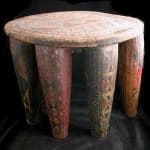African Art / Nupe Wooden Polychrome Stool, 20th Century CE
Wood and Paint
17 x 12.5
PF.5142
Further images
In the 1830's, the Nupe tribe converted to Islam. Evidence of this conversion can be seen in their art, such as this handsome stool. A band of alternating black and...
In the 1830's, the Nupe tribe converted to Islam. Evidence of this conversion can be seen in their art, such as this handsome stool. A band of alternating black and red triangles, outlined with gold circles, decorates the outer rim of the circular stool. In the center a bold black zigzag, or “lightening bolt,” is bordered by incised red lines at right angles. The effect is one of flowing energy and power, suitable to the role of stools in African society as objects of prestige owned by kings and high priests. The eight legs bear intricate designs in an “iron cross” pattern, and various triangular configurations, highlighted by a series of gold circles that give the impression of studs. Two of the legs contain human figures--a male and female pair facing each other, the woman carrying a baby on her back; and two males face to face. All the figures are dressed in Western style clothing. Nupe art is characterized by very fine woodcarving, and we may justifiably add figural painting, with this stool serving as a fine example.





